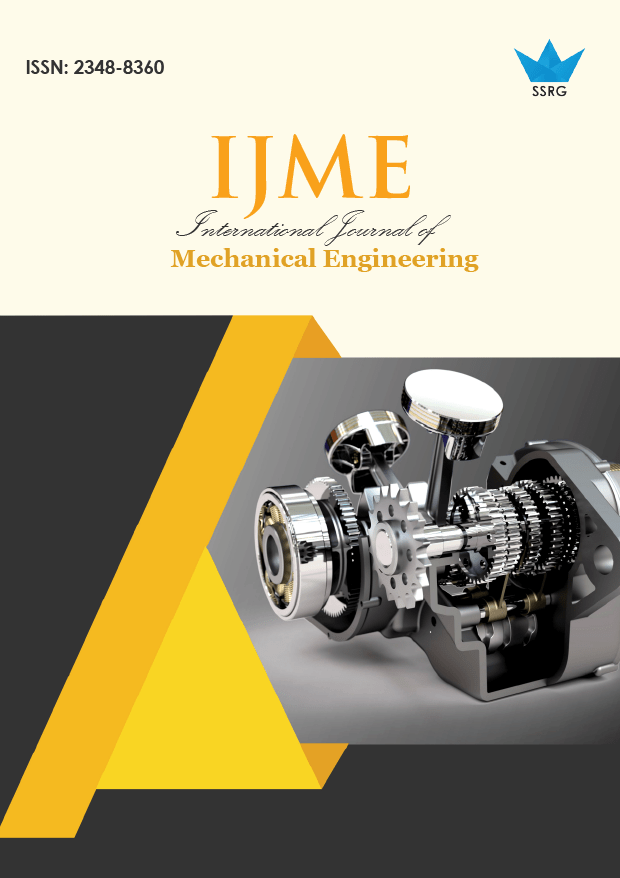Mechanical Behaviour and Morphological Studies of Infused Carbon Fillers with Different Weight Ratios in Polyurethane Foam

| International Journal of Mechanical Engineering |
| © 2025 by SSRG - IJME Journal |
| Volume 12 Issue 10 |
| Year of Publication : 2025 |
| Authors : Rajesh Addanki, Sanjay Anand Rao Khalane |
How to Cite?
Rajesh Addanki, Sanjay Anand Rao Khalane, "Mechanical Behaviour and Morphological Studies of Infused Carbon Fillers with Different Weight Ratios in Polyurethane Foam," SSRG International Journal of Mechanical Engineering, vol. 12, no. 10, pp. 129-137, 2025. Crossref, https://doi.org/10.14445/23488360/IJME-V12I10P111
Abstract:
Polyurethane foams with short carbon fiber materials are being used in shape memory, aerospace, sports goods, and biomedical applications. This study emphasises the tensile behaviour of Polyurethane (PU) foam added with Chopped Carbon Fibers (CCF) mixture of 250 microns with different weight ratios 0.25%, 0.5% and 1%. Four configurations are cast in a mould, tensile samples are prepared and experimentally validated in a universal testing machine by capturing cross-head displacements and gauge strains. A load displacement drop is noticed to 1.61 times for a maximum weight percentage of 1% CCF mixture. Experimental results showed that the addition of chopped carbon fibers to PU foam has improved the tensile strength. CCF content of 0.5 wt% % showed a tensile strength increase to 73% and a tensile modulus increase to 56% compared to specimens with 0 wt% of CCF content. A morphological examination was carried out, and the developments in TS25C, TS50C, and TS100C specimens showed improvement in cell density from 1.95 to 6 times and a drop in cell size from 13.68 to 75.89%. Maximum density increased in TS100C specimens is upto 19.6% as compared to TS0C. Agglomeration is noticed with a percentage increase of CCF in PUF with more than 0.5 wt%.
Keywords:
Chopped carbon fibers, Polyurethane foam cast, Tensile behavior study, Displacement and strain characteristics, SEM morphology.
References:
[1] “Standard Test Method for Tensile Properties of Plastics, ASTM D 638 -14,” ASTM International, pp. 1-17, 2022.
[CrossRef] [Google Scholar] [Publisher Link]
[2] Nuno V. Gama, Artur Ferreira, and Ana Barros-Timmons, “Polyurethane Foams: Past, Present, and Future,” Materials, vol. 11, no. 10, pp. 1-35, 2018.
[CrossRef] [Google Scholar] [Publisher Link]
[3] E. Hammel et al., “Carbon Nanofibers for Composite Applications,” Carbon, vol. 42, no. 5-6, pp. 1153-1158, 2004.
[CrossRef] [Google Scholar] [Publisher Link]
[4] Richard A. Vaia, and Emmanuel P. Giannelis, “Polymer Nanocomposites: Status and Opportunities,” MRS Bulletin, vol. 26, no. 5, pp. 394-401, 2001.
[CrossRef] [Google Scholar] [Publisher Link]
[5] L. James Lee et al., “Polymer Nanocomposite Foams,” Composites Science and Technology, vol. 65, no. 15-16, pp. 2344-2363, 2005.
[CrossRef] [Google Scholar] [Publisher Link]
[6] Joanna Ryszkowska et al., “Dispersion of Carbon Nanotubes in Polyurethane Matrix,” Physica E: Low-dimensional Systems and Nanostructures, vol. 39, no. 1, pp. 124-127, 2007.
[CrossRef] [Google Scholar] [Publisher Link]
[7] G. Harikrishnan et al., “Nanodispersion of Carbon Nano Fibers for Polyurethane Foaming,” Polymer, vol. 51, no. 15, pp. 3349-3353, 2010.
[CrossRef] [Google Scholar] [Publisher Link]
[8] Farzana Hussain et al., “Review Article: Polymer-Matrix Nanocomposites, Processing, Manufacturing, and Application: An Overview,” Journal of Composite Materials, vol. 40, no. 17, pp. 1511-1575, 2006.
[CrossRef] [Google Scholar] [Publisher Link]
[9] Christopher C. Ibeh, and Monika Bubacz, “Current Trends in Nanocomposite Foams,” Journal of Cellular Plastics, vol. 44, no. 6, pp. 493-515, 2008.
[CrossRef] [Google Scholar] [Publisher Link]
[10] Sanghyeon Ju et al., “Preventing the Collapse Behavior of Polyurethane Foams with the Addition of Cellulose Nanofiber,” Polymers, vol. 15, no. 6, pp. 1-13, 2023.
[CrossRef] [Google Scholar] [Publisher Link]
[11] Hesheng Xia, and Mo Song, “Preparation and Characterization of Polyurethane–Carbon Nanotube Composite,” Soft Matter, vol. 1, no. 5, pp. 386-394, 2005.
[CrossRef] [Google Scholar] [Publisher Link]
[12] Ayesha Kausar, “Polyurethane Composite Foams in High-Performance Applications: A Review,” Polymer-Plastics Technology and Engineering, vol. 57, no. 4, pp. 346-369, 2017.
[CrossRef] [Google Scholar] [Publisher Link]
[13] F. Stazi et al., “Carbon Nanofibers in Polyurethane Foams: Experimental Evaluation of Thermo-Hygrometric and Mechanical Performance,” Polymer Testing, vol. 67, pp. 234-245, 2018.
[CrossRef] [Google Scholar] [Publisher Link]
[14] M.C. Saha, Md. E. Kabir, and S. Jeelani, “Enhancement in Thermal and Mechanical Properties of Polyurethane Foam Infused with Nanoparticles,” Material Science and Engineering: A, vol. 479, no. 1-2, pp. 213-222, 2008.
[CrossRef] [Google Scholar] [Publisher Link]
[15] Martin Kuběna et al., “On the Tensile Tests of Polyurethane and Its Composites with Carbon Nanotubes,” Advances in Materials Science and Engineering, vol. 2019, no. 1, pp. 1-8, 2019.
[CrossRef] [Google Scholar] [Publisher Link]
[16] C. Torres-Sanchez et al., “Enhanced Interfacial Adhesion and Mechanical Performance of Lightweight Polyurethane Foam Reinforced with a Low Content of Aligned Magnetised Short Carbon Fibres,” Composite Interfaces, vol. 28, no. 3, pp. 309-328, 2020.
[CrossRef] [Google Scholar] [Publisher Link]
[17] Walid Naous et al., “Morphology, Tensile Properties, and Fracture Toughness of Epoxy/Al2O3 Nanocomposites,” Journal of Polymer Science: Part B: Polymer Physics, vol. 44, no. 10, pp. 1466-1473. 2006.
[CrossRef] [Google Scholar] [Publisher Link]
[18] G.J. Withers et al., “Improved Mechanical Properties of a Water-Activated Polyurethane-Glass Fiber Composite Reinforced with Amino-Functionalized Carbon Nanofibers,” Journal of Composite Materials, vol. 50, no. 6, pp. 783-793, 2015.
[CrossRef] [Google Scholar] [Publisher Link]
[19] Mustafa Özgür Öteyaka, Kerem Aybar, and Hasan Candan Öteyaka, “A Comparative Study of the Effect of Polyurethane Nanofiber and Powders Filler on the Mechanical Properties of Carbon Fiber and Glass Fiber Composites,” Pamukkale University Journal of Engineering Sciences, vol. 28, no. 1, pp. 51-57, 2022.
[Google Scholar] [Publisher Link]
[20] Habib Siddiqi Ahsan Najeeb, “Influence of Carbon Nanotubes on Mechanical Properties of Polyurethane Composites,” Journal of Pollution Effects & Control, vol. 8, no. 5, pp. 1-5, 2020.
[Publisher Link]
[21] Mohammad Hadi Moghim, and Seyed Mojtaba Zebarjad, “Tensile Properties and Deformation Mechanisms of PU/ MWCNTs Nanocomposites,” Polymer Bulletin, vol. 74, pp. 4267-4277, 2017.
[CrossRef] [Google Scholar] [Publisher Link]
[22] Sandhya S. Gedam et al., “Thermal, Mechanical and Morphological Study of Carbon Nano Tubes Graphene Oxide and Silver Nanoparticles based Polyurethane Composites,” Materials Research Express, vol. 6, no. 8, 2019.
[CrossRef] [Google Scholar] [Publisher Link]
[23] Janis Andersons, Mikelis Kirpluks, and Ugis Cabulis, “Reinforcement Efficiency of Cellulose Microfibers for the Tensile Stiffness and Strength of Rigid Low-Density Polyurethane Foams,” Materials, vol. 13, no. 12, pp. 1-15, 2020.[CrossRef] [Google Scholar] [Publisher Link]

 10.14445/23488360/IJME-V12I10P111
10.14445/23488360/IJME-V12I10P111